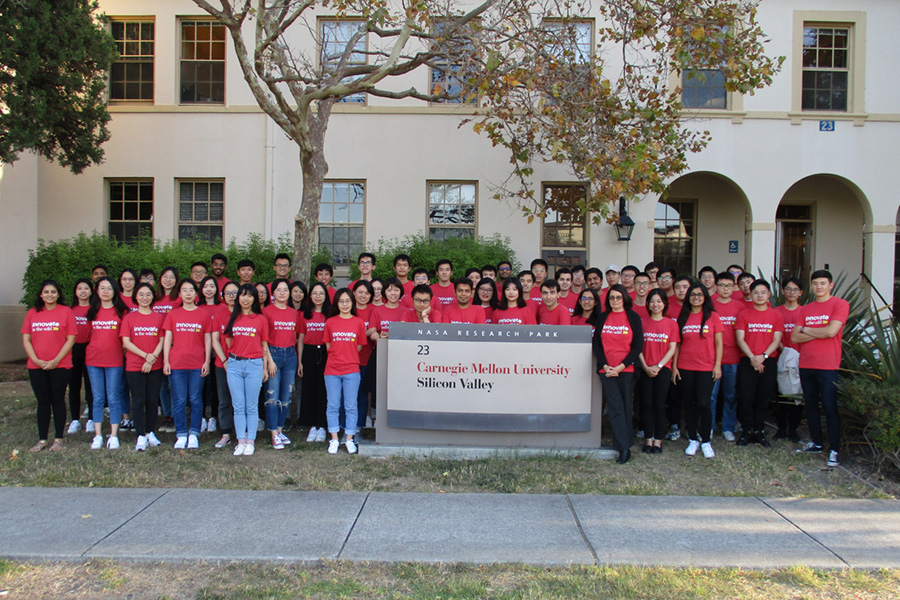
Showcasing Practicum Projects at CMU Silicon Valley
By Jessica Shirley
Throughout the fall 2019 semester, Information Networking Institute (INI) bicoastal master's students have innovated in the wild through practicum projects sponsored by tech companies, startups and government agencies. At this event, INI students will showcase their practicum work in computing, mobile systems and security through dynamic presentations and project exhibits.
Thank you to our sponsors!
Carnegie Mellon University
Datrium
Ericsson
NASA
Procter & Gamble
SLAC National Accelerator Laboratory
U.S. Geological Survey
Visa
Fall 2019 Projects
CMU: HTTP Cookies Without Consent
This project categorizes websites’ cookie consent notices and quantifies how many popular websites in the U.S. and Ireland offer consent choices. The results of this study will inform policymakers who are interested in learning how well privacy and security laws work in practice (e.g. Europe’s GDPR, California’s CCPA, etc.).
CMU: A Distributed Marketplace for Machine Learning
Machine learning researchers have resource constraints due to limited local hardware when performing research, yet unused hardware while between projects. This team built a distributed machine learning marketplace that lets users contribute unused graphics processing units (GPU) in exchange for future credits to perform distributed machine learning tasks.
CMU: Blockchain-Enabled Real-Time Hotspot Sharing
A cryptographically secure and public ledger of transactions, i.e. the blockchain, can facilitate a decentralized marketplace where owners’ network equipment (like routers) can offer network services (like bandwidth) to users. This project considers hotspot or router sharing, wherein a user looking for internet connectivity may transparently acquire access to a privately-owned hotspot nearby.
CMU: Security of National ID Infrastructure
A country’s identification system is the backbone for effective delivery of public and private services (e.g. social security numbers in the U.S.). These systems can also pose security threats to citizens. This team investigated security properties of national ID systems, such as the Modular Open Source Identity Platform (MOSIP), as well as other similar national ID infrastructure systems.
CMU: Augmenting Tele-Conferencing with Machine Vision
Remote meeting participants are often unable to see whiteboards well due to angle and lighting issues. This team worked to provide a better experience using only a high-resolution video camera. The interaction is more natural and does not require any hardware setup, but rather relies upon computer vision techniques to implement a novel solution.
Datrium: Data Plane for Containerization
Datrium provides fast primary storage and efficient data management in the same platform. This project extends these capabilities and brings them to Kubernetes (k8s). Datrium platform enables the user to create, use, and snapshot k8s persistent volumes. Metadata about files in the snapshots will be indexed and searchable so that a user can find and retrieve files from the persistent volume snapshots.
Ericsson: Industrial Voice User Interface
Voice User Interfaces (VUI) have gained popularity with consumer-focused voice assistants. There are different challenges to VUI in industrial settings, such as the prevalence of outside noise like industrial machinery. In this project, students will train a VUI engine that is robust against background noise for use in an industrial setting.
Ericsson: Real Time Video Anonymization
Video recording is pervasive. While faces are sometimes blurred before showing footage, there is not much automation. Moreover, a blur effect typically not only anonymizes the subject but also loses information like the subject gaze or facial expression. This project prototyped blurring people and objects in real-time, while preserving non-identifiable information.
NASA: Simulation, Modeling, Visualization, Algorithms, and Data Analysis for Improving Airport Surface Operations
This project expands prior work by previous CMU practicum teams to build a fast-time simulator of surface movement for large airports (e.g. San Francisco airport). The simulator allows for a comparison of different models and planning/scheduling algorithms for optimizing surface movement. The ultimate goals are to achieve higher throughput, reduce the complexity of operations, and improve safety.
Procter & Gamble: Voice Based Authentication System
Particularly in manufacturing, authentication by password has a great deal of overhead and decreases productivity. This project investigates seamless login, enabling efficient authentication without compromising security and safety. The primary use case is geared towards enabling manufacturing employees, but the intent is to apply a potential solution(s) throughout the enterprise.
SLAC: SCRIPT - Smart Charging Infrastructure Planning Tool
Adding electric vehicles and solar panels to the power grid can actually impact the system negatively if not properly managed. The SCRIPT project forecasts future charging needs of travelers based on historical and survey data, and performs a cost-benefit analysis of investment in charging infrastructure development from the point of view of different stakeholders.
SLAC: Load Modeling and Grid Modernization
This project is developing LOADINSIGHT, which automates data collection, data cleaning, and verification of data sets used by the North American Electricity Reliability Corporation (NERC). The project extends prior work to establish a pipeline with a modern front-end UI and secure authentication, as well as flexibility in auto deployment and a robust back-end framework.
SLAC: Energy Data X
The U.S. power grid produces enormous volumes of sensor-generated data which contributes to real-time situational awareness that maintains safe and efficient operations. This project aims to build a cloud-based data pipeline and visualizations for energy data including meter data, solar generation, charging station data, and urban mobility data.
U.S. Geological Survey: Planning Land Gravity Surveys
Variations in Earth’s gravity provide critical information for finding natural resources and understanding natural hazards. Measuring the gravitational field is time-consuming and often performed in remote areas. This project uses a novel combination of classic computer science algorithms, spatial data structures, and machine learning tools to more efficiently route vehicles during gravity surveys.
Visa: Sequential Anomaly Detection for Runtime Application Behavior
Threat actors can attack applications to compromise high-value data or sensitive information. One key security goal is to be able to detect anomalous behavior within the sequential context of entity behavior. This project researches and compares multiple unsupervised sequential anomaly detection models in order to build an open-sourced library to train on time series data and flag anomalous sequences as potentially malicious events, with a threshold based anomaly score.
